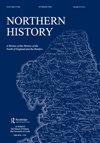R.文森特,《科尔尼山谷:奔宁风景的历史》
IF 0.2
3区 历史学
Q2 HISTORY
引用次数: 0
摘要
或者它们之间的差异(如果有的话)。手稿一直在约克公会手中,直到18世纪末,该公会基本上已经解散。这份手稿在1881年进入大英图书馆之前的后续历史可以追溯。医学历史学家希望有更多关于中世纪图像的细节;尽管它们生动且在出版物中广泛使用,但每本书只有几页。将这四种气质的图像与约翰·德·福克斯顿早期的《自由宇宙》中的一系列非常奇怪的图像进行比较真的没有意义,尽管它也是约克的产品。有一些当代大陆的例子可能更有益于研究。编辑经常抱怨整个手稿中都有错误,例如图像的标签,但将它们视为有意义的变体可能会更有成效。与中世纪的医学图像相比,王室肖像似乎得到了更多的历史和艺术分析。医学历史学家和约克的专家都想更多地了解那些在这些对开本中留下自己名字的从业者的早期现代职业生涯。有时,不愿提供更多约克公会业务的例子令人沮丧。附录中有一张有趣的图表,显示了三个世纪以来公会学徒人数的波动,但并没有真正进行分析。这份手稿似乎是未来约克医学生韵律学研究的金矿,尤其是在17世纪和18世纪。提供按字母顺序排列的人名列表,包括他们所有提到的人,确实使这本书对进一步研究非常有用,尽管在手稿中断章取义的决定确实打破了编辑手稿的正常惯例。尽管有一些奇怪之处,可能暗示了一些潜在的竞争目标,但这是一本引人入胜的书,毕竟是一本版本,而不是一本专著,这意味着空间是有限的。它是博伊德尔和约克中世纪出版社合资创办的医学史上一个有吸引力的新系列的首批出版物之一。这些卷印刷精美,装订精美,图像复制质量非常好。这本书将是任何书架上的一个漂亮的补充,尤其是对于任何对约克公会历史感兴趣的人来说。本文章由计算机程序翻译,如有差异,请以英文原文为准。
R. VINCENT, Colne Valley: A History of a Pennine Landscape
or how they might have differed from each other (if at all). The manuscript remained in the hands of the York guild through until the late eighteenth century by which time the guild was largely defunct. The subsequent history of the manuscript until it came into the hands of the British Library in 1881 is well-traced. Medical historians would wish there to be more detail on the medieval images; there are only a few pages on each of them despite their vividness and wide usage in publications. It really did not make sense to compare the image of the four temperaments with a very odd series of images from the much earlier Liber Cosmographiae of John de Foxton, despite it being also a York product. There are contemporary continental examples that might have been more useful to examine. The editor often complains that there are mistakes throughout the manuscript, for example in the labels to images, but it might have been more productive to see them as meaningful variations. The royal portraits seem to get more historical and artistic analysis than the medieval medical images. Both medical historians and York specialists would like to know more about the early-modern careers of the practitioners who left their names in these folios. At times the reluctance to provide more examples of guild business in York is frustrating. There is an intriguing graph in an appendix showing the fluctuating numbers of apprentices in the guild over three centuries, but it is not really analysed. The manuscript would seem to be a gold mine for future prosopographical studies of York medics, especially in the seventeenth and eighteenth centuries. The provision of the names as an alphabetized list of people, including all their mentions together, does make the book very useful for further research, although the decision to take them out of their context in the manuscript does break normal conventions of editing a manuscript. Despite a few oddities, which might suggest some underlying competing goals, this is a fascinating volume that is after all an edition, not a monograph, meaning that space was limited. It comes out as one of the first publications in an attractive new series in medical history, a joint venture by Boydell and York Medieval Press. These volumes are beautifully printed and bound, with very good quality reproductions of images. This book would be a handsome addition to any shelf, especially for anyone interested in the guild history of York.
求助全文
通过发布文献求助,成功后即可免费获取论文全文。
去求助
来源期刊

Northern History
Multiple-
CiteScore
0.20
自引率
33.30%
发文量
37
期刊介绍:
Northern History was the first regional historical journal. Produced since 1966 under the auspices of the School of History, University of Leeds, its purpose is to publish scholarly work on the history of the seven historic Northern counties of England: Cheshire, Cumberland, Durham, Lancashire, Northumberland, Westmorland and Yorkshire. Since it was launched it has always been a refereed journal, attracting articles on Northern subjects from historians in many parts of the world.
 求助内容:
求助内容: 应助结果提醒方式:
应助结果提醒方式:


